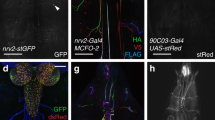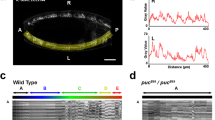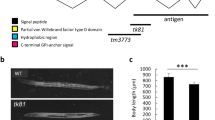Abstract
Networks in the CNS consist of neural modules that are connected in a repetitive array. Whereas individual modules contain guidance information along which axons track within the unit, these guidance cues hinder axon extension across module boundaries. We investigated how axons solve this 'boundary problem' by analyzing the longitudinal connections of neuromeres in Drosophila melanogaster. The initial trajectory of the longitudinal axons is guided by Netrin, which is localized on commissural axons by its receptor, Frazzled. The Netrin cue on the commissure of the next segment can act as a barrier to longitudinal axons, inhibiting their extension and misguiding them contralaterally along the commissure. We show that, before reaching the segmental boundary, the longitudinal axons' responsiveness to Netrin presented on the commissure is suppressed by Roundabout (ROBO), through counteracting Gq signaling. The absence of suppression causes the robo phenotype: longitudinal axons project toward the midline, as if running around a roundabout (rotary).
This is a preview of subscription content, access via your institution
Access options
Subscribe to this journal
Receive 12 print issues and online access
$209.00 per year
only $17.42 per issue
Buy this article
- Purchase on Springer Link
- Instant access to full article PDF
Prices may be subject to local taxes which are calculated during checkout







Similar content being viewed by others
References
Burrows, M. Anatomy of the nervous system. in The Neurobiology of an Insect Brain 12–14 (Oxford Univ. Press, New York, 1996).
Jessell, T.M. & Sanes, J.R. The induction and patterning of the nervous system. in Principles of Neural Science 4th edn. (eds. Kandel, E.R., Schwartz, J.H. & Jessell, T.M.) Ch. 52, 1021 (Elsevier Science Publishing, New York, 2000).
Hubel, D.H. & Wiesel, T.N. Shape and arrangement of columns in cat's striate cortex. J. Physiol. (Lond.) 165, 559–568 (1963).
Ishii, N., Wadsworth, W.G., Stern, B.D., Culotti, J.G. & Hedgecock, E.M. UNC-6, a laminin-related protein, guides cell and pioneer axon migrations in C. elegans. Neuron 9, 873–881 (1992).
Hedgecock, E.M., Culotti, J.G. & Hall, D.H. The unc-5, unc-6, and unc-40 genes guide circumferential migrations of pioneer axons and mesodermal cells on the epidermis in C. elegans. Neuron 4, 61–85 (1990).
Harris, R., Sabatelli, L.M. & Seeger, M.A. Guidance cues at the Drosophila CNS midline: identification and characterization of two Drosophila Netrin/UNC-6 homologs. Neuron 17, 217–228 (1996).
Mitchell, K.J. et al. Genetic analysis of Netrin genes in Drosophila: Netrins guide CNS commissural axons and peripheral motor axons. Neuron 17, 203–215 (1996).
Serafini, T. et al. The Netrins define a family of axon outgrowth-promoting proteins homologous to C. elegans UNC-6. Cell 78, 409–424 (1994).
Kidd, T., Bland, K.S. & Goodman, C.S. Slit is the midline repellent for the robo receptor in Drosophila. Cell 96, 785–794 (1999).
Brose, K. et al. Slit proteins bind robo receptors and have an evolutionarily conserved role in repulsive axon guidance. Cell 96, 795–806 (1999).
Kidd, T. et al. Roundabout controls axon crossing of the CNS midline and defines a novel subfamily of evolutionarily conserved guidance receptors. Cell 92, 205–215 (1998).
Shirasaki, R., Katsumata, R. & Murakami, F. Change in chemoattractant responsiveness of developing axons at an intermediate target. Science 279, 105–107 (1998).
Hiramoto, M., Hiromi, Y., Giniger, E. & Hotta, Y. The Drosophila Netrin receptor Frazzled guides axons by controlling Netrin distribution. Nature 406, 886–889 (2000).
Seeger, M., Tear, G., Ferres-Marco, D. & Goodman, C.S. Mutations affecting growth cone guidance in Drosophila: genes necessary for guidance toward or away from the midline. Neuron 10, 409–426 (1993).
Flanagan, J.G. & Van Vactor, D. Through the looking glass: axon guidance at the midline choice point. Cell 92, 429–432 (1998).
Stoeckli, E.T. & Landmesser, L.T. Axon guidance at choice points. Curr. Opin. Neurobiol. 8, 73–79 (1998).
Bashaw, G.J., Kidd, T., Murray, D., Pawson, T. & Goodman, C.S. Repulsive axon guidance: Abelson and Enabled play opposing roles downstream of the Roundabout receptor. Cell 101, 703–715 (2000).
Hidalgo, A. & Brand, A.H. Targeted neuronal ablation: the role of pioneer neurons in guidance and fasciculation in the CNS of Drosophila. Development 124, 3253–3262 (1997).
Goodman, C.S. Embryonic development of the Drosophila central nervous system. in The Development of Drosophila Melanogaster (eds Bate, M. & Arias, A.M.) 1171–1180 (Cold Spring Harbor Laboratory Press, New York, 1993).
Bastiani, M.J., du Lac, S. & Goodman, C.S. Guidance of neuronal growth cones in the grasshopper embryo. I. Recognition of a specific axonal pathway by the pCC neuron. J. Neurosci. 6, 3518–3531 (1986).
Keleman, K. et al. Comm sorts Robo to control axon guidance at the Drosophila midline. Cell 110, 415–427 (2002).
Kolodziej, P.A. et al. frazzled encodes a Drosophila member of the DCC immunoglobulin subfamily and is required for CNS and motor axon guidance. Cell 87, 197–204 (1996).
Gitai, Z., Yu, T.W., Lundquist, E.A., Tessier-Lavigne, M. & Bargmann, C.I. The Netrin receptor UNC-40/DCC stimulates axon attraction and outgrowth through Enabled and, in parallel, Rac and UNC-115/AbLIM. Neuron 37, 53–65 (2003).
Furrer, M.P., Kim, S., Wolf, B. & Chiba, A. Robo and Frazzled/DCC mediate dendritic guidance at the CNS midline. Nat. Neurosci. 6, 223–230 (2003).
Winberg, M.L., Mitchell, K.J. & Goodman, C.S. Genetic analysis of the mechanisms controlling target selection: complementary and combinatorial functions of Netrins, semaphorins, and IgCAMs. Cell 93, 581–591 (1998).
Johnson, K.G. et al. Axonal heparan sulfate proteoglycans regulate the distribution and efficiency of the repellent Slit during midline axon guidance. Curr. Biol. 14, 499–504 (2004).
Steigemann, P., Molitor, A., Fellert, S., Jackle, H. & Vorbruggen, G. Heparan sulfate proteoglycan syndecan promotes axonal and myotube guidance by Slit/Robo signaling. Curr. Biol. 14, 225–230 (2004).
Stein, E. & Tessier-Lavigne, M. Hierarchical organization of guidance receptors: silencing of Netrin attraction by Slit through a Robo/DCC receptor complex. Science 291, 1928–1938 (2001).
Ming, G.L. et al. cAMP-dependent growth cone guidance by Netrin-1. Neuron 19, 1225–1235 (1997).
Ratnaparkhi, A., Banerjee, S. & Hasan, G. Altered levels of Gq activity modulate axonal pathfinding in Drosophila. J. Neurosci. 22, 4499–4508 (2002).
Berstein, G. et al. Phospholipase C-beta 1 is a GTPase-activating protein for Gq/11, its physiologic regulator. Cell 70, 411–418 (1992).
Lechleiter, J.D. & Clapham, D.E. Molecular mechanisms of intracellular calcium excitability in X. laevis oocytes. Cell 69, 283–294 (1992).
Uchiyama, T., Yoshikawa, F., Hishida, A., Furuichi, T. & Mikoshiba, K. A novel recombinant hyperaffinity inositol 1,4,5-trisphosphate (IP3) absorbent traps IP3, resulting in specific inhibition of IP3-mediated calcium signaling. J. Biol. Chem. 277, 8106–8113 (2002).
Sabatier, C. et al. The divergent Robo family protein Rig-1/Robo3 is a negative regulator of Slit responsiveness required for midline crossing by commissural axons. Cell 117, 157–169 (2004).
Jen, J.C. et al. Mutations in a Human ROBO Gene disrupt hindbrain axon pathway crossing and morphogenesis. Science 304, 1509–1513 (2004).
Wang, Q. & Wadsworth, W.G. The C domain of Netrin UNC-6 silences calcium/calmodulin-dependent protein kinase- and diacylglycerol-dependent axon branching in Caenorhabditis elegans. J. Neurosci. 22, 2274–2282 (2002).
Lim, Y.S., Mallapur, S., Kao, G., Ren, X.C. & Wadsworth, W.G. Netrin UNC-6 and the regulation of branching and extension of motoneuron axons from the ventral nerve cord of Caenorhabditis elegans. J. Neurosci. 19, 7048–7056 (1999).
Yoshikawa, S., McKinnon, R.D., Kokel, M. & Thomas, J.B. Wnt-mediated axon guidance via the Drosophila Derailed receptor. Nature 422, 583–588 (2003).
Bonkowsky, J.L., Yoshikawa, S., O'Keefe, D.D., Scully, A.L. & Thomas, J.B. Axon routing across the midline controlled by the Drosophila Derailed receptor. Nature 402, 540–544 (1999).
Hivert, B., Liu, Z., Chuang, C.Y., Doherty, P. & Sundaresan, V. Robo1 and Robo2 are homophilic binding molecules that promote axonal growth. Mol. Cell. Neurosci. 21, 534–545 (2002).
Tessier-Lavigne, M. & Goodman, C.S. The molecular biology of axon guidance. Science 274, 1123–1133 (1996).
Colamarino, S.A. & Tessier-Lavigne, M. The axonal chemoattractant netrin-1 is also a chemorepellent for trochlear motor axons. Cell 81, 621–629 (1995).
Noakes, P.G., Gautam, M., Mudd, J., Sanes, J.R. & Merlie, J.P. Aberrant differentiation of neuromuscular junctions in mice lacking S-laminin/laminin Beta 2. Nature 374, 258–262 (1995).
Porter, B.E., Weis, J. & Sanes, J.R.A. Motoneuron-selective stop signal in the synaptic protein S-laminin. Neuron 14, 549–559 (1995).
Saheki, Y. et al. A new approach to inhibiting astrocytic IP3-induced intracellular calcium increase in an astrocyte-neuron co-culture system. Brain Res. 1055, 196–201 (2005).
Mlodzik, M. & Hiromi, Y. Enhancer trap method in Drosophila: its application to neurobiology. In “Gene Expression in Neural Tissues”. Methods in Neurosciences 9, 397–414 (1992).
Tear, G. et al. commissureless controls growth cone guidance across the CNS midline in Drosophila and encodes a novel membrane protein. Neuron 16, 501–514 (1996).
Grenningloh, G., Rehm, E.J. & Goodman, C.S. Genetic analysis of growth cone guidance in Drosophila: fasciclin II functions as a neuronal recognition molecule. Cell 67, 45–57 (1991).
Rothberg, J.M., Jacobs, J.R., Goodman, C.S. & Artavanis-Tsakonas, S. Slit: an extracellular protein necessary for development of midline glia and commissural axon pathways contains both EGF and LRR domains. Genes Dev. 4, 2169–2187 (1990).
Hummel, T., Krukkert, K., Roos, J., Davis, G. & Klambt, C. Drosophila Futsch/22C10 Is a MAP1B-like Protein Required for Dendritic and Axonal Development. Neuron 26, 357–370 (2000).
Acknowledgements
We thank C.S. Goodman, A. Hidalgo, P. Kolodziej, M. Seeger, G. Technau, A. Ratnaparkhi and the Bloomington Stock Center for fly strains; P. Kolodziej, M. Seeger and the DSHB for fly DNA clones and antibodies; M. Matsushita and S. Li for the GFP-IP3 sponge cDNA; K. Takei for helpful advice on the IP3 experiment; T. Katsuki, T. Nagasaka and all the members of the Hiromi laboratory for helpful discussions; Y. Iketani, M. Aono and C. Asaka for technical assistance; and E. Giniger and S. Butler for helpful advice on the manuscript. This work was funded by the Precursory Research for Embryonic Science and Technology (M.H.) and the Core Research for Evolutional Science and Technology (Y.H.) programs of the Japan Science and Technology Agency. Funding was also provided by the Japan Society for the Promotion of Science (M.H.) and the Ministry of Education, Science, Sports and Culture of Japan (Y.H.).
Author information
Authors and Affiliations
Corresponding authors
Ethics declarations
Competing interests
The authors declare no competing financial interests.
Supplementary information
Supplementary Fig. 1
Sequential patterning of commissural and longitudinal axons. (PDF 6033 kb)
Rights and permissions
About this article
Cite this article
Hiramoto, M., Hiromi, Y. ROBO directs axon crossing of segmental boundaries by suppressing responsiveness to relocalized Netrin. Nat Neurosci 9, 58–66 (2006). https://doi.org/10.1038/nn1612
Received:
Accepted:
Published:
Issue Date:
DOI: https://doi.org/10.1038/nn1612
This article is cited by
-
Commissural axon guidance in the developing spinal cord: from Cajal to the present day
Neural Development (2019)
-
Netrin (UNC-6) mediates dendritic self-avoidance
Nature Neuroscience (2012)



